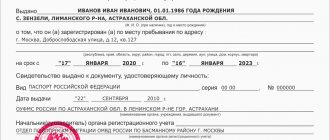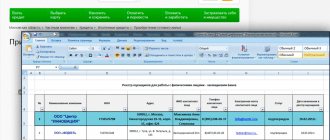Moscow and Moscow region » Exchange of apartments with additional payment through a mortgage
Currently, direct exchange of apartment for apartment is rare. Most often we are talking about buying and selling, because it is generally not possible to find two practically equivalent apartments for a regular exchange. The high cost of real estate and financial difficulties do not allow everyone to buy or exchange an apartment, using personal finances as an additional payment. Therefore, the exchange of apartments with an additional payment through a mortgage is becoming increasingly popular. Such a deal makes sense if a person wants to improve their living conditions by exchanging a small apartment for a more spacious one or one located in a more prestigious or convenient area. A mortgage loan is taken out for the amount of the price difference between the existing and purchased apartment. An exchange in which the sale of an apartment occurs with the simultaneous purchase of a new apartment (with an additional payment) is usually called alternative. For such exchanges, many banks are developing special mortgage lending programs. To understand the complex nuances of mortgage schemes, the help of an experienced specialist is often required.
Exchange of apartments with additional mortgage payment is possible in several options
- The borrower simultaneously sells old housing and buys new housing, using a mortgage loan to pay the difference in the cost of apartments. Thus, the apartment that the borrower buys will be pledged to the bank. If the apartment the borrower wants to buy costs more than the proceeds from the sale of the old home along with the mortgage loan, the borrower pays the remaining amount himself.
- To exchange an apartment with an additional mortgage payment, the borrower pledges his old apartment to the bank. The bank, in turn, will give the borrower about 70% of its value. As in the first case, if the purchased apartment costs more than the 70% received from the bank, the borrower must additionally find the missing amount.
- The borrower pledges an apartment to the bank, receiving 70% of the cost from it, and takes out a mortgage for the remaining amount secured by a new apartment. It turns out that both the old and the new apartment are under collateral. This is the most difficult option for exchanging an apartment with an additional mortgage payment, and it is more suitable for people with a strong financial condition.
What will the lender say?
All operations that the borrower plans to carry out with the collateral apartment must be coordinated with the lender. When executing a mortgage agreement on real estate, a collateral encumbrance is issued. At the same time, the mortgagee is the full owner of the property, which is confirmed by the corresponding entry in the Unified State Register of Real Estate. The bank acts as a pledge holder, and without its consent, the owner cannot sell, donate, lease or perform other actions with the pledged property. The collateral encumbrance on the apartment is registered through Rosreestr and confirmed by an entry in the Unified State Register of Real Estate. It is impossible to bypass the bank when making transactions with a mortgaged apartment. The borrower may not ask the bank’s permission for the transaction only after full payment of the loan and removal of the encumbrance.
According to Article 345 of the Civil Code of the Russian Federation on the replacement and restoration of the collateral, the collateral property can be replaced with another collateral if the borrower and the bank agree. The mortgagor is obliged to inform the bank in writing of his intention to replace the collateral housing. The response from the bank also comes in writing. The waiting period for a response is determined by the terms of the mortgage agreement between the parties. Instead of replacing the collateral, you can enter into a new collateral agreement for a new object. The old mortgage becomes invalid.
The pledgee has the right to refuse to replace the pledged item. For the lender, this is a waste of time that will not bring additional income. For the borrower, the likelihood of success will increase if the new collateral fully satisfies the bank's requirements. Each organization may have additional requirements for real estate, so it is best to check with your lender for a complete list of requirements.
Possible options for conducting a transaction for exchanging a collateral apartment:
- direct exchange of one option for another with replacement of collateral;
- sale of one apartment and purchase of another with registration of a new mortgage and cancellation of the old one;
- using a consumer loan to pay off a mortgage and remove encumbrances from an apartment.
What is the most profitable way to exchange one mortgaged apartment for another? All three options have their pros and cons, which are discussed below.
What documents will be needed
To carry out the exchange of a mortgaged apartment, you must prepare the following set of papers:
- borrower's passport (with copies of each page);
- documents confirming the client’s stable employment and current work experience;
- documents confirming solvency (at least for the last six months);
- documents for the purchased apartment.
This is the main set of documents. Additionally, the bank may request a TIN, military ID, SNILS, certificate of marriage/divorce, consent from the spouse to the transaction, etc.
As for the documents for the purchased apartment, you will need:
- title papers (certificate of ownership);
- an extract from the house register indicating all those registered in a particular property;
- cadastral passport of living space;
- a certificate from the governing body confirming that there are no debts for housing and communal services (for example, a certificate from a HOA);
- real estate appraisal report completed by an accredited appraisal company.
We suggest you read: How to write a letter to the prosecutor's office (sample) || How to contact the prosecutor
The updated list of required documentation may differ slightly depending on the selected bank.
The legislation of the Russian Federation does not prohibit the exchange of housing encumbered with a mortgage for another. Therefore, the answer to the question “Is it possible to exchange an apartment with a mortgage {q}” will be positive. The main condition of such a transaction is the mandatory receipt of official permission from the lender. Having received the bank's consent, the borrower can choose one of the options for replacing the mortgaged apartment: using an exchange agreement, a double purchase and sale agreement, or by initially removing the encumbrance on the mortgaged housing and its subsequent sale.
Exchange directly
Equal exchange
This method is most relevant when exchanging equivalent options in different areas or regions. The main difficulty is to find the owner of a suitable apartment who will agree to the exchange. Often on Internet sites, advertisements of real estate sellers who are ready to exchange are posted in the appropriate section.
Procedure for direct exchange of a mortgaged apartment for another property:
- We are looking for a suitable option;
- we notify the bank of the intention to replace the collateral and provide a full package of documents for the new object: assessment, title and technical documents;
- We are waiting for the bank's decision;
- we draw up an exchange agreement;
- the collateral is replaced.
If the new housing is located in the same locality, there will be fewer difficulties. It is more difficult to agree on exchanging a mortgaged apartment for a non-resident option. This is only possible if in the region where the new collateral is located there is a branch of the bank that issued the mortgage. The cost of the new collateral is also important. If the apartment is much cheaper, the bank may refuse to replace the collateral. On the other hand, if a significant portion of the mortgage is already paid off, this may not be as significant.
How to obtain bank consent
Each financial institution puts forward certain conditions before allowing the exchange of the collateral. The most common requirements are the following:
- the applicant has a positive credit history and has been faithfully repaying the loan for several years (at least 3-5) (or has repaid at least 20-30% of its amount);
- long-term cooperation with a financial institution. Approval will most likely be received if the applicant has opened a deposit in this bank or is a payroll client;
- the new mortgaged apartment must be located in the region where the lender operates.
Exchange through purchase and sale
The most difficult option from a documentary point of view is a double deal. Given the difficulty of finding exchange options, this is the most suitable solution for many mortgagers. Procedure:
- we find a buyer for a mortgaged apartment;
- We obtain consent from the bank for the sale of collateralized housing;
- we find suitable real estate for ourselves;
- We get approval for a mortgage for a new home;
- we sell the mortgaged apartment and pay the bank for the first loan;
- We purchase a new home with the conclusion of a new mortgage agreement (the bank may be different).
There are nuances in this scheme that should be taken into account from the very beginning:
- The bank removes the encumbrance on the property only after the loan debt has been fully repaid. To do this, the buyer must make an advance payment in the amount of the remaining debt, and the purchase and sale transaction will be registered only after the bank encumbrance is removed. Such a scheme may scare away the buyer, and the apartment will have to be sold at a significant discount;
- If you apply for a new mortgage before the first loan is paid off, your income must be sufficient to pay both loans at the same time. To be on the safe side, it is better to apply for a new mortgage after paying off the old one.
When exchanging a mortgage for a mortgage through a double purchase and sale, the initiator of the transaction is not limited in choosing a new home. In exchange for an old apartment, he can receive a new building or a house with a plot - it all depends on his desire, capabilities and the willingness of bank employees to meet him halfway. If you are planning to take out a house on credit, you need to immediately clarify the possibility of purchasing the land with a mortgage. Some banks are ready to provide money for the purchase of a house if the buyer pays for the plot out of his own pocket.
Preparation
To carry out the exchange, you must adhere to the following procedure.
You need to start by studying the loan agreement.
Each bank describes in detail the actions of the borrower and its own in this document, and most likely the clause on the sale or exchange of collateral real estate is stipulated in the document.
In order to understand all the intricacies of the process and find out in which regions the action is possible, it is worth consulting directly with the organization’s employees.
If you want to exchange an apartment for housing in another city, it must be no further than 1000 km away. from the bank branch. The collateral housing is regularly checked by inspectors, and they must reach it within one day.
After consultation and familiarization with the terms of a possible transaction, it is necessary to select a suitable property. Confidence in the integrity of the owner is a necessary condition for the success of the transaction, because a delay in payment on his part can result in serious troubles.
It should be noted that this step is one of the most difficult. Therefore, it is more advisable to involve a reliable real estate agency to solve the problem, preferably one that cooperates with your bank.
More on the topic The blender burned out, can it be repaired?
Then the borrower, together with the bank’s security service, checks the object for which the exchange is planned. The object is inspected by the housing department or management company, tax authorities, Federal Migration Service, Unified State Register. At the same time, the second participant in the exchange is checked for criminal records.
In the absence of circumstances that impede the transaction, the preparation of a package of documents begins.
The third stage of preparation is collecting documents. Preparation of the package occurs simultaneously with the search for housing options. The list of documents consists of the following items:
- loan agreement;
- copy of personal account;
- documents for the object cancellation;
- extract from the house register;
- personal documents of the parties to the transaction;
- certificate of absence of debt on loans;
- marriage certificate (if available);
- consent to exchange registered at the address;
- technical certificates and floor plans of premises;
- act of assessing an object.
Transaction via consumer loan
Transaction without the participation of a bank
It is possible to exclude the bank from the housing exchange chain with the help of a consumer loan. Using a consumer loan to pay off a mortgage is possible if the amount of the remaining debt is not very large and if the borrower has sufficient income to obtain another loan from the bank.
Borrower's procedure:
- we issue a consumer loan for the required amount;
- paying off the mortgage;
- we remove the bank's encumbrance from the apartment;
- we sell real estate without restrictions;
- We are buying a new apartment.
The downside is higher interest rates on a consumer loan than on a mortgage. Additional complications in this scheme are possible if the new housing costs more than the sold apartment. Then you will have to take out a consumer loan for a larger amount or look for other ways to pay the difference. You can get a new mortgage - it will still be easier than the double purchase and sale of mortgaged housing with the participation of the bank.
Exchange of an apartment with a military mortgage
Military personnel are most often faced with the need to exchange mortgage housing. For example, a military man took out a mortgage for a one-room apartment 10 years ago, during which time he got married and had children, and he needs a larger apartment. But the mortgage loan has not yet been repaid, and maternity capital funds cannot be used to pay off the military mortgage by law. Or a military man was transferred to serve in another region, and he is forced to move from an apartment that was mortgaged with NIS funds.
To resolve such issues, the Federal State Institution “Rosvoenipoteka” has developed the “Moving” program. The program was aimed at secondary lending in case of need to improve living conditions or when a NIS participant who is already paying a mortgage moves. At the moment, the section with the “Moving” program on the Rosvoenipoteka website is not working. In January 2020, the need to resume this program was announced; as a result, the “Military Mortgage for the Second Time” program was introduced, aimed at solving the same problems. This program is being implemented by one of the commercial banks. Exchanging an apartment with a military mortgage involves a large number of nuances, so for the success of the transaction it is better to contact a competent intermediary.
Exchange of a mortgage apartment with minor children
Exchange of an apartment with children
If there are minor children among the owners of the apartment, permission for the transaction will have to be obtained from the guardianship and trusteeship authorities. But the bank does not accept real estate encumbered with the rights of minors as collateral. Typically, minor family members receive ownership of a share in the mortgaged property after the loan has been repaid and the encumbrance on the apartment has been removed. Most often this happens when maternity capital is used to repay part of the loan or interest on it. When transferring certificate funds towards a housing loan, parents write a notarial undertaking, according to which they are obliged to allocate shares to their children within six months after repaying the mortgage.
In the described situation, parents will still have to interact with the guardianship authorities. The task of the regulatory authority is to make sure that after the exchange, living conditions for children will be no worse than those that existed before the transaction. If the mortgaged apartment is exchanged for a more expensive or equivalent in size and quality living space, problems with guardianship most likely will not arise. When the new apartment is smaller than the old one, it will be impossible to obtain permission from the guardianship authorities.
If maternity capital was not involved and parents have no obligation to include children among the owners, you can take advantage of this. If an exchange is necessary, it will be enough to register the children in another home, and guardianship permission for the transaction will not be needed.
Exchanging an apartment with a mortgage is a complex type of transaction with collateral. Each case has its own characteristics, so to choose the optimal solution it is better to turn to experienced intermediaries.
Ways to solve the problem
The traditional option for exchanging an apartment that is under mortgage is to replace the collateral. This procedure has its own characteristics depending on the price difference between the old and new living space. With this exchange method, the borrower has the following options:
- Replacement is carried out subject to the equivalent market value of both apartments. At the same time, the new property may have either a larger or smaller area compared to the one that is currently under mortgage encumbrance. This is explained by the quality of housing, its territorial location, and the presence or absence of internal contents. The equivalent exchange method is distinguished by the fact that it is easier and faster to process, and therefore is preferable for both the bank and the client.
- Housing is being exchanged for a cheaper one. This option rarely receives bank approval, since it is unprofitable for any creditor to change the current collateral to a less liquid one. Such a transaction is possible only if the borrower repays more than 65% of the principal mortgage debt.
- Housing is being exchanged for a more expensive one. Unlike the previous option, banks are interested in this replacement method, since the value of the collateral will increase and credit risks will be reduced. A price difference of at least 20% is beneficial for the lender. The additional payment for a new apartment is made at the expense of the client’s own funds, or the bank can offer a consumer loan (if the borrower has a sufficient level of solvency).
More on the topic Documents for a donation agreement for an apartment - what are needed to formalize a deed of gift in 2020
If the bank refuses to replace the collateral, then you can resort to alternative exchange options. These include the execution of an agreement for the assignment of obligations to the creditor. Along with the property, the status of borrower is transferred to the new owner, provided that he is satisfied with the terms of the current mortgage agreement.
You can also use a consumer loan to get out of the situation - use borrowed funds to pay off the mortgage, remove the encumbrance and draw up a purchase and sale agreement for the new owner. Next, you should repay the loan using the money received and take out a new housing loan.
The exchange of a mortgaged apartment is possible by law, but getting the go-ahead for it is not so easy. The lender needs to calculate its own risks in this situation, so each of them puts forward its own conditions. Most often, borrowers are offered two options:
- Paying off your mortgage by taking out a new short-term loan. Under this scheme, the living space is removed from the collateral by issuing funds to pay the mortgage in the form of a short-term loan. Objects are changed “with an additional payment”, and the money received goes to repay the loan. Alternatively, the debt is repaid at the expense of the buyer. That is, housing is sold with an encumbrance in the form of collateral. The balance of the debt is paid off from the additional payment received at the time of sale.
- Assignment of debt. The buyer purchases from the borrower not living space, but a loan. In this case, the borrower changes, but the payment schedule and the amount of debt remain unchanged. This scheme rarely works, since the new borrower must satisfy the lender, and such a buyer of real estate is extremely difficult.
The disadvantage of this option is the difficulty of obtaining a new loan if you have a mortgage.
Read on our website about how to exchange a two-room apartment, whether it is possible to exchange a room for a house and land, and how to conclude an exchange agreement with an additional payment.









